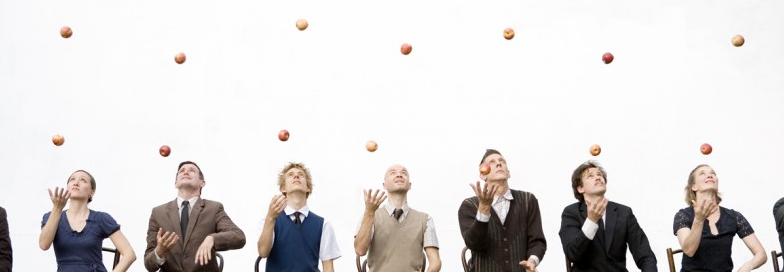Juggling Notation
- Roger Mansuy, Mathematician
- 29 sept. 2017
- 3 min de lecture

Photo credit: Gandini Juggling Smashed
[ C H R O N I C L E ]
It’s late summer; are you looking for something fun and unproductive? You’ve only got a couple of balls... …so you are ready for maths. Start by tossing the balls gracefully. If you keep it up for more than a couple of seconds, or try to explain (or teach) the wonderful movements you have just made, you quickly realise that you need an adapted language, precise and to the point, to describe your gestures. In other words, you need “juggling notation”.
For the simple case of asynchronous juggling (each hand throws alternately), a juggling pattern can be described easily using a finite series of integers. The idea is as follows: the flight time of each ball is noted (or equivalently, the height of the throws). If the first figure is 3, that means that the first hand throws a ball at T1 that will remain in the air for 3 beats and will be caught at T4=3+1; if the second figure is 4, the ball thrown by the other hand on the next beat (T2) will be caught at T6=2+4 and so on. The figure 0 is special, because it indicates an empty hand (i.e. a ball at throw time 0). Figure 1 indicates a transfer between the two hands, and by convention, figure 2 is a ball that remains in the hand without being thrown. So a juggling pattern is described by a succession of integers. Unless you are exceptionally talented, this is a periodic sequence as you repeat the same movements at some time or another. Then you only need to memorise one period.
Siteswap, the economical language to describe juggling, was invented by American mathematicians in the 1980s. For example, the infinite series 33333... (also known as siteswap 3) indicates that each hand will in turn thrown a ball that will remain in the air for 3 beats; the left hand throws, the right throws, the left throws, the right catches the first ball and throws it again, the left catches the second ball and throws it again, etc. This pattern is known as the 3-ball cascade but there are many others: 42 corresponds to a yo-yo (one hand throws the ball and catches it, the other does nothing), 55500 is not the postcode for a town in France, but a 3-ball flash (three balls thrown at a different rhythm). Using this language, we have an easy way of encoding, decoding and communicating a juggling pattern in the form of a mathematical object, and of proving theorems. For example, if your siteswap has a length that is odd, you note that your figure is “symmetrical”; after a period in the pattern, the right hand will be doing what the left did and vice versa. Slightly more difficult: you can find the number of balls needed to execute a pattern as the average of the numbers in the corresponding siteswap (so, for the 55500, you need (5+5+5+0+0)/5=3 balls).
Plenty of questions quickly become exercises in mathematics. Is the pattern 53445 feasible? How can you combine two patterns? This last question raises another algebraic one: if you know how to combine siteswaps, what is the structure of their whole (product)? The answer is complicated, technically: it is said to belong an affine Coxeter group of Ãn. This doesn’t really get you very far, but you could always use the information to save face when you drop the balls on the ground!
> AUTHOR
Roger Mansuy
Mathematician
Roger is a teacher at the Louis-le-Grand secondary school in Paris. Evenry month, he explains a mathematical issue in a public talk.


Commentaires